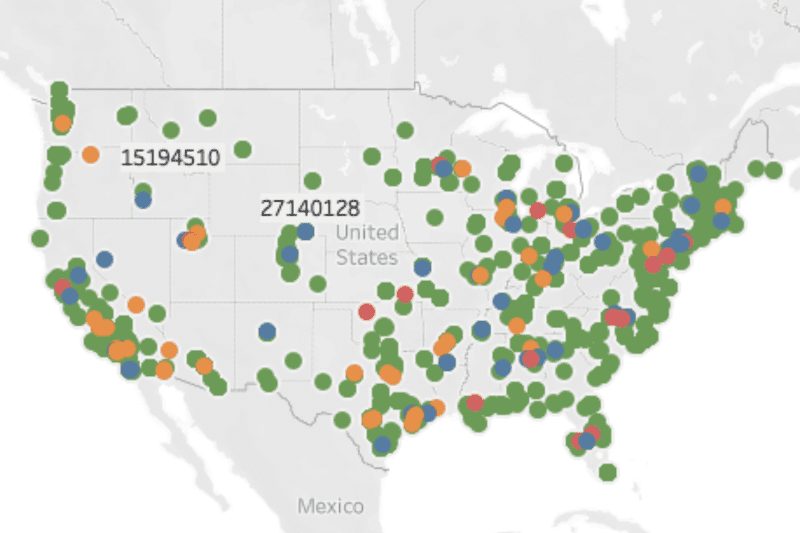MAPPING PFAS
PFAS Waste Generation and Disposal
Through a Freedom of Information Act request, PEER received data from EPA on PFAS transfers identified in hazardous waste e-manifests and state waste code searches. This data and the map PEER produced has information on the generation, storage, and disposal of almost 14 million kilograms of waste contaminated with PFAS between July 2018 and August 2021.
To address the threat posed by toxic per-and polyfluoroalkyl substances (PFAS) chemicals, EPA announced a PFAS action plan almost three years ago under the Trump administration. One part of the plan called for developing an interactive map that would show sources and concentrations of PFAS in the environment. When EPA did not produce the map, we sent records requests to EPA for data and information about the map.
As part of this effort, we recently received an EPA data set on PFAS identified in RCRA electronic –manifests (e-manifests) and state waste code searches. EPA’s data, and the map PEER produced from it, provide information on the generation, storage and/or disposal of 6,545 shipments of almost 14 million kilograms of waste contaminated with PFAS between July 2018 and August 2021. It documents the generation and disposal of PFAS waste across the country, which includes methods such as incineration, landfilling, mixing with other fuels and burning it, discharging it into wastewater treatment systems, and injecting it underground.
These data likely contain a small fraction of the actual PFAS waste shipments that occurred during this time period. This is because PFAS are not regulated under the Resource Conservation and Recovery Act (RCRA), the federal law designed to ensure the safe management of hazardous wastes – during their generation, transportation, treatment, storage, and disposal. It provides an important glimpse into shipments and disposal of waste contaminated with PFAS, something that has occurred largely under the radar of federal and state regulators. You can view the data and the map we produced here.
As part of RCRA, EPA established a national e-manifest system to track hazardous waste shipments. Hazardous wastes regulated under RCRA are assigned waste codes that are reported on the e-manifest. Because toxic PFAS wastes are not currently regulated under RCRA, they are not required to be identified under federal law on the e-manifest. Some facilities, however, have chosen to identify their waste as containing PFAS on the e-manifest. EPA’s data set identified these PFAS shipments through the Department of Transportation’s description of the shipping name, hazard class or division, or packing group; or the general description of the waste.
Although these data likely represent a small fraction of the PFAS waste shipments, they indicate:
-
- The top disposal methods for PFAS waste include incineration, other recovery or reclamation for reuse, fuel blending, landfilling, and “neutralization,” a term that has no significance when disposing of PFAS;
- The “Management Method Description” in over 50% of the shipments was “storage, bulking and/or off-site transfer.” The data set had no information on the final disposition of the PFAS waste that was listed in this category;
- Facilities in Washington state generated and received the largest number of shipments of waste containing PFAS over the four-year period;
- Facilities in Nevada, Ohio, Texas, Washington, and California received more than 10 million kilograms of waste, or around 78% of all the waste identified in the EPA data; and,
- Facilities in California, Texas, West Virginia, Vermont, and Washington generated more than 10 million kilograms of waste, around 78% of the generated waste identified in the EPA data.
 A key cause for concern in managing PFAS waste is there is no known way to safely dispose of or destroy PFAS. PFAS, often referred to as “forever chemicals,” do not break down in the environment and many bio-accumulate in the food chain — and in us. Human exposure to high levels of PFAS is associated with cancer, birth defects, developmental damage to infants, and impaired functioning of the liver, kidneys, and immune system.
A key cause for concern in managing PFAS waste is there is no known way to safely dispose of or destroy PFAS. PFAS, often referred to as “forever chemicals,” do not break down in the environment and many bio-accumulate in the food chain — and in us. Human exposure to high levels of PFAS is associated with cancer, birth defects, developmental damage to infants, and impaired functioning of the liver, kidneys, and immune system.
Waste containing PFAS disposed of in landfills pose a threat to human health and the environment because PFAS can leak from landfills and severely pollute groundwater —the primary source of drinking water for half the country. Throughout the U.S., communities are finding sewage sludge contaminated with PFAS. This sludge is often used as a fertilizer and works its way back into the food chain, contaminating the food supply and destroying the livelihood of farmers
Likewise, incinerating waste containing PFAS expels the PFAS into the environment and threatens our air quality and health. Incinerating or burning waste does not break down the PFAS. In fact, when burned, PFAS have been shown to travel up to 150 kilometers, contaminating surrounding communities and water supplies.
Blending PFAS waste with fuel and burning it also causes contamination of surrounding communities. Fuel blending involves mixing PFAS waste with other fuels to be burned in an incinerator, a cement kiln, or an industrial furnace.
Regulating the disposal of PFAS waste is imperative to tackling the growing PFAS contamination crisis, yet it is something EPA has refused to do. A significant goal of PEER is to have EPA regulate PFAS waste under RCRA. On September 19, 2019, PEER petitioned EPA to develop regulations under RCRA Subtitle C for generators, transporters, and owners or operators of treatment, storage, and disposal facilities to ensure the safe management and disposal of wastes containing PFAS. EPA has not responded to our petition. The Environmental Law Clinic at the University of California at Berkeley and the Governor of New Mexico have also petitioned EPA to regulate PFAS waste under RCRA.
EPA’s failure to address the cradle-to-grave management of waste contaminated with PFAS under RCRA means the problems associated with PFAS contamination will grow exponentially worse over time, imposing tremendous financial, health, and environmental costs on society, while allowing those who created the problem to avoid or minimize their financial responsibility for the harm caused by this waste.
EPA seems ok with this situation. We are not.
 Tim Whitehouse is the Executive Director of PEER. Among other things, Tim formerly served as an EPA enforcement attorney.
Tim Whitehouse is the Executive Director of PEER. Among other things, Tim formerly served as an EPA enforcement attorney.
